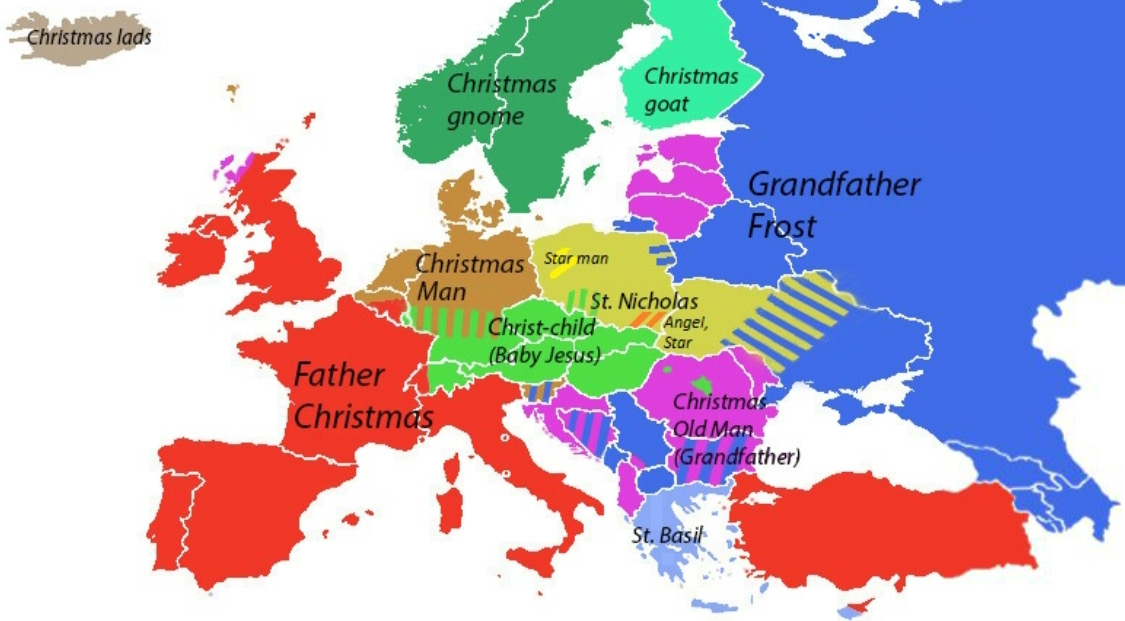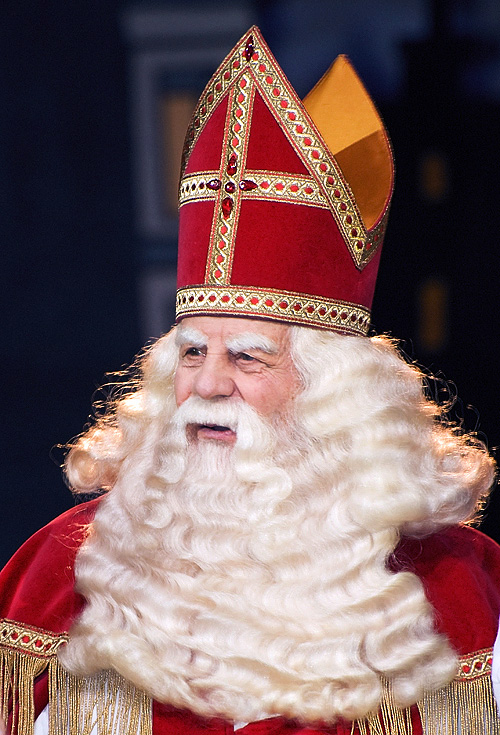|
Christmas Gift-bringers Around The World
This is a list of Christmas and winter gift-bringer figures from around the world. The history of mythical or folkloric gift-bringing figures who appear in winter, often at or around the Christmas period, is complex, and in many countries the gift-bringer – and the gift-bringer's date of arrival – has changed over time as native customs have been influenced by those in other countries. While many though not all gift-bringers originated as religious figures, gift-bringing is often now a non-religious custom and secular figures exist in many countries that have little or no tradition of celebrating Christmas as a religious festival. Some figures are entirely local, and some have been deliberately and more recently invented. The main originating strands – all of which have their roots in Europe – are * the overlapping winter-based and religious Old Man traditions (St Nicholas, Santa Claus, Father Christmas, St Basil, Grandfather Frost), * the Christ Child traditions pro ... [...More Info...] [...Related Items...] OR: [Wikipedia] [Google] [Baidu] |
Father Time
Father Time is a personification of time. In recent centuries he is usually depicted as an elderly bearded man, sometimes with wings, dressed in a robe and carrying a scythe and an hourglass or other timekeeping device. As an image, "Father Time's origins are curious." The ancient Greeks themselves began to associate ''chronos'', their word for time, with the agricultural god Cronos, who had the attribute of a harvester's sickle. The Romans equated Cronos with Saturn, who also had a sickle, and was treated as an old man, often with a crutch. The wings and hourglass were early Renaissance additions and he eventually became a companion of the Grim Reaper, personification of Death, often taking his scythe. He may have as an attribute a snake with its tail in its mouth, an ancient Egyptian symbol of eternity. New Year Around New Year's Eve, the media (in particular editorial cartoons) use the convenient trope of Father Time as the personification of the previous year (or "th ... [...More Info...] [...Related Items...] OR: [Wikipedia] [Google] [Baidu] |
Lorraine
Lorraine , also , , ; Lorrain: ''Louréne''; Lorraine Franconian: ''Lottringe''; german: Lothringen ; lb, Loutrengen; nl, Lotharingen is a cultural and historical region in Northeastern France, now located in the administrative region of Grand Est. Its name stems from the medieval kingdom of Lotharingia, which in turn was named after either Emperor Lothair I or King Lothair II. Lorraine later was ruled as the Duchy of Lorraine before the Kingdom of France annexed it in 1766. From 1982 until January 2016, Lorraine was an administrative region of France. In 2016, under a reorganisation, it became part of the new region Grand Est. As a region in modern France, Lorraine consisted of the four departments Meurthe-et-Moselle, Meuse, Moselle and Vosges (from a historical point of view the Haute-Marne department is located in the region), containing 2,337 communes. Metz is the regional prefecture. The largest metropolitan area of Lorraine is Nancy, which had developed for centu ... [...More Info...] [...Related Items...] OR: [Wikipedia] [Google] [Baidu] |
Alsace
Alsace (, ; ; Low Alemannic German/ gsw-FR, Elsàss ; german: Elsass ; la, Alsatia) is a cultural region and a territorial collectivity in eastern France, on the west bank of the upper Rhine next to Germany and Switzerland. In 2020, it had a population of 1,898,533. Alsatian culture is characterized by a blend of Germanic and French influences. Until 1871, Alsace included the area now known as the Territoire de Belfort, which formed its southernmost part. From 1982 to 2016, Alsace was the smallest administrative ''région'' in metropolitan France, consisting of the Bas-Rhin and Haut-Rhin departments. Territorial reform passed by the French Parliament in 2014 resulted in the merger of the Alsace administrative region with Champagne-Ardenne and Lorraine to form Grand Est. On 1 January 2021, the departments of Bas-Rhin and Haut-Rhin merged into the new European Collectivity of Alsace but remained part of the region Grand Est. Alsatian is an Alemannic dialect closely related ... [...More Info...] [...Related Items...] OR: [Wikipedia] [Google] [Baidu] |
Joulupukki
Joulupukki is a Finnish Christmas figure. The name ''joulupukki'' literally means "Christmas goat" or " Yule Goat" in Finnish; the word ''pukki'' comes from the Germanic root ''bock'', which is a cognate of the English "buck", and means "billy-goat". An old Scandinavian custom, the figure is now often conflated with Santa Claus. Origins and description The ''Joulupukki'' was originally a pagan tradition. The Joulupukki may also be a man turned into a goat-man on Christmas Eve (as depicted in Elsa Beskow's ''Peter and Lotta's Christmas''). Today, in some parts of Finland, the custom persists of persons performing in goat costume in return for leftover Christmas food. The performer traditionally is an older man, who is called a "'". He usually wears warm red robes, but with a broad band of blue near the fur, uses a walking stick, and travels in a sleigh pulled by a number of reindeer (which do not fly, unlike Santa Claus' team). In Lapland, he rides in a ''pulkka'', rather than ... [...More Info...] [...Related Items...] OR: [Wikipedia] [Google] [Baidu] |
Julemanden
( fo, Jólamaður, kl, Juulimaaq) is the Christmas gift-bringer in modern Danish culture, the equivalent of Father Christmas or Santa Claus. can be directly translated as "The Yule-Man" or "The Christmas-man". is often illustrated as a short, bearded man dressed in gray clothes and a red hat. He is said to bring presents on Christmas Eve (December 24), coming to houses either by foot or by sleigh, and often wears fur to keep him warm. History The roots of reach into Danish folklore and mythology. However, the character is a relatively new phenomenon in Denmark, appearing some time after World War II (1939–1945). Until then, there was , or – a character with some resemblance to the modern . This tradition can be traced back centuries, when people believed in (elves, leprechauns, spirits or mystical entities rarely or never seen directly). Local folklore dictated the expected actions of the , which could be moody creatures resulting in all kinds of fortunes or even ... [...More Info...] [...Related Items...] OR: [Wikipedia] [Google] [Baidu] |
Saint Lucy
Lucia of Syracuse (283–304), also called Saint Lucia ( la, Sancta Lucia) better known as Saint Lucy, was a Roman Christian martyr who died during the Diocletianic Persecution. She is venerated as a saint in the Catholic, Anglican, Lutheran, and Eastern Orthodox churches. She is one of eight women (including the Virgin Mary) explicitly commemorated by Catholics in the Canon of the Mass. Her traditional feast day, known in Europe as Saint Lucy's Day, is observed by Western Christians on 13 December. Lucia of Syracuse was honored in the Middle Ages and remained a well-known saint in early modern England. She is one of the best known virgin martyrs, along with Agatha of Sicily, Agnes of Rome, Cecilia of Rome and Catherine of Alexandria. Sources The oldest record of her story comes from the fifth-century ''Acts of the Martyrs''. The single fact upon which various accounts agree is that a disappointed suitor accused Lucy of being a Christian, and she was executed in Syracuse, ... [...More Info...] [...Related Items...] OR: [Wikipedia] [Google] [Baidu] |
Easter
Easter,Traditional names for the feast in English are "Easter Day", as in the '' Book of Common Prayer''; "Easter Sunday", used by James Ussher''The Whole Works of the Most Rev. James Ussher, Volume 4'') and Samuel Pepys''The Diary of Samuel Pepys, Volume 2'') as well as the single word "Easter" in books printed i157515841586 also called Pascha (Aramaic, Greek, Latin) or Resurrection Sunday, is a Christian festival and cultural holiday commemorating the resurrection of Jesus from the dead, described in the New Testament as having occurred on the third day of his burial following his crucifixion by the Romans at Calvary . It is the culmination of the Passion of Jesus Christ, preceded by Lent (or Great Lent), a 40-day period of fasting, prayer, and penance. Easter-observing Christians commonly refer to the week before Easter as Holy Week, which in Western Christianity begins on Palm Sunday (marking the entrance of Jesus in Jerusalem), includes Spy Wednesday (on whic ... [...More Info...] [...Related Items...] OR: [Wikipedia] [Google] [Baidu] |
Père Noël
Père Noël (), "Father Christmas", sometimes called 'Papa Noël' ("Daddy Christmas"), is a legendary gift-bringer at Christmas in France and other French-speaking areas, identified with the Father Christmas and/or Santa Claus of English-speaking territories. Though they were traditionally different, all of them are now the same character, with different names, and the shared characteristics of a red outfit, workshop at the North Pole/ Lapland, and a team of reindeer. According to tradition, on Christmas Eve children leave their shoes by the fireplace filled with carrots and treats for Père Noël's donkey, Gui (French for "Mistletoe") before they go to bed. Père Noël takes the offerings and, if the child has been good, leaves presents in their place. Presents are traditionally small enough to fit in the shoes; candy, money or small toys. Père Noël is sometimes confused with another character. In Eastern France (Alsace and Lorraine regions), in Belgium, in Switzerland, and ... [...More Info...] [...Related Items...] OR: [Wikipedia] [Google] [Baidu] |
Sinterklaas
Sinterklaas () or Sint-Nicolaas () is a legendary figure based on Saint Nicholas, patron saint of children. Other Dutch names for the figure include ''De Sint'' ("The Saint"), ''De Goede Sint'' ("The Good Saint") and ''De Goedheiligman'' ("The Good Holy Man"). Many descendants and cognates of "Sinterklaas" or "Saint Nicholas" in other languages are also used in the Low Countries, nearby regions, and former Dutch colonies. The feast of Sinterklaas celebrates the name day of Saint Nicholas on 6 December. The feast is celebrated annually with the giving of gifts on St. Nicholas' Eve (5 December) in the Netherlands and on the morning of 6 December, Saint Nicholas Day, Belgium, Luxembourg, western Germany, northern France (French Flanders, Lorraine, Alsace and Artois), and Hungary. The tradition is also celebrated in some territories of the former Dutch Empire, including Aruba. Sinterklaas is one of the sources of the popular Christmas icon of Santa Claus. Figures Sinterklaas ''S ... [...More Info...] [...Related Items...] OR: [Wikipedia] [Google] [Baidu] |
Nikolaus
Nicholas is a male given name and a surname. The Eastern Orthodox Church, the Roman Catholic Church, and the Anglican Churches celebrate Saint Nicholas every year on December 6, which is the name day for "Nicholas". In Greece, the name and its derivatives are especially popular in maritime regions, as St. Nicholas is considered the protector saint of seafarers. Origins The name is derived from the Greek name Νικόλαος (''Nikolaos''), understood to mean 'victory of the people', being a compound of νίκη ''nikē'' 'victory' and λαός ''laos'' 'people'.. An ancient paretymology of the latter is that originates from λᾶς ''las'' ( contracted form of λᾶας ''laas'') meaning 'stone' or 'rock', as in Greek mythology, Deucalion and Pyrrha recreated the people after they had vanished in a catastrophic deluge, by throwing stones behind their shoulders while they kept marching on. The name became popular through Saint Nicholas, Bishop of Myra in Lycia, the inspiratio ... [...More Info...] [...Related Items...] OR: [Wikipedia] [Google] [Baidu] |








